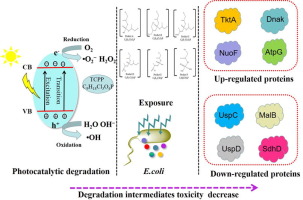Chemical Engineering Journal ( IF 13.3 ) Pub Date : 2019-05-28 , DOI: 10.1016/j.cej.2019.05.193 Xiaolong Yu , Hua Yin , Jin Shao Ye , Hui Peng , Guining Lu , Zhi Dang

|
As a class of emerging organic contaminants (EOCs), organophosphate flame retardants (OPFRs) have been raising concern due to their persistence, bioaccumulation and toxicity. Therefore, it is urgent need to develop environmental-friendly and high-efficient techniques to remove OPFRs. The degradation kinetics and mechanism of tris-(2-chloroisopropyl) phosphate (TCPP), a representative OPFRs, by UV/TiO2 photocatalytic degradation were explored in current research. It was found that degradation reaction was well documented by first-order kinetics with a kobs of 0.3146 min−1, and hydroxyl radical was identified as a dominating contributor for the TCPP elimination. Simultaneously, six steady intermediate products were generated with the release of Cl− and PO43− as photocatalytic reaction further proceeded. The degradation efficiency can be interfered by natural organic matters, anions and pH value, implying that an incomplete mineralization of TCPP could be ubiquitous in heterogeneous water matrix. Combining the proteomics analysis with KEGG metabolism networks analysis, the process of transmembrane transport and energy generation in Escherichia coli altered by intermediates has proved that the intermediates could be transported and utilized through cellular metabolism. Moreover, the diminution of stress resistance suggested that the toxicity of degradation products through UV/TiO2 photocatalytic degradation was lower than that of intact TCPP. To sum up, environmental safety of degrading intermediate products and the satisfactory detoxification effect of TCPP were identified under appropriate mineralization, indicating that UV/TiO2 photocatalysis technique was safe and high-efficient for TCPP control.
中文翻译:

通过UV / TiO 2光催化降解磷酸三(2-氯异丙基)酯:使用蛋白质组学分析评估降解中间体的动力学,途径和安全风险
作为一类新兴的有机污染物(EOC),有机磷酸盐阻燃剂(OPFR)由于其持久性,生物蓄积性和毒性而引起了人们的关注。因此,迫切需要开发环保,高效的技术来去除OPFR。降解动力学和三(2-氯异丙基)磷酸酯(TCPP)的机构,代表OPFRs,通过UV /的TiO 2的光催化降解在目前的研究进行了探索。发现降解反应已被一阶动力学很好地证明,其ak obs为0.3146 min -1,并且羟基被认为是TCPP消除的主要贡献者。同时,随着Cl-的释放,产生了六种稳定的中间产物。PO 4 3-作为光催化反应进一步进行。降解效率会受到天然有机物,阴离子和pH值的干扰,这表明TCPP的不完全矿化可能在非均质水基质中普遍存在。蛋白质组学分析与KEGG代谢网络分析相结合,被中间体改变的大肠埃希菌跨膜转运和能量产生过程已证明该中间体可以通过细胞代谢进行转运和利用。此外,耐应力性的降低表明降解产物通过UV / TiO 2的毒性光催化降解低于完整的TCPP。综上所述,在适当的矿化条件下,确定了降解中间产物的环境安全性和TCPP令人满意的解毒效果,表明UV / TiO 2光催化技术对TCPP的控制是安全,高效的。


















































 京公网安备 11010802027423号
京公网安备 11010802027423号